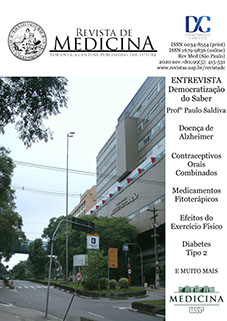Associated between sedentary behavior and diabetes in low-income older adults in the city of Ibicuí-BA: brazilian population survey
DOI:
https://doi.org/10.11606/issn.1679-9836.v99i5p442-447Keywords:
Elderly, Chronic Disease, Exercise., Elderly, Chronic Disease, Exercise.Abstract
The aim of this study was to estimate a cut-off point in the time spent in sedentary behavior as a discriminator of the presence of diabetes mellitus in the elderly population. Methods: cross-sectional study, population-based, with data from 310 low-income elderly people from Ibicuí-BA, Brazil, randomly selected. Sedentary behavior was assessed by time spend in sitting week and weekend, and diabetes was assed by self-reported. The data were analyzed using descriptive statistics, Received Operations Curve, and Poisson regression (p ≤ 0.05). The mean time spent in sedentary activities was 272.63 ± 163.71 min/day. The overall prevalence of diabetes was 13.5%. The sociodemographic characteristics, life habits and presence of diabetes have not been shown a statistically significant association (p> 0.05). The area under the ROC curve was 0.60, 95% CI (0.54-0.65) and p=0.003 and the cutoff point was >325 min/day which best discriminated the presence of diabetes mellitus between the elderly people. The raw and adjusted analysis for the association between sedentary behavior and diabetes revealed no association between the variables. It was identified that the time spent in sedentary behavior has a good discriminatory capacity for the presence of diabetes mellitus. On the other hand, there was no association between the first one and the presence of Diabetes, after adjustment for the intervening variables.
Downloads
References
Ogurtsova K, da Rocha Fernandes J, Huang Y, Linnenkamp U, Guariguata L, Cho NH, et al. IDF Diabetes atlas: global estimates for the prevalence of diabetes for 2015 and 2040. Diabetes Res Clin Pract Suppl. 2017;128:40-50. doi.org/10.1016/j.diabres.2017.03.024.
Saeedi P, Petersohn I, Salpea P, Malanda B, Karuranga S, Unwin N, et al. Global and regional diabetes prevalence estimates for 2019 and projections for 2030 and 2045: results from the International Diabetes Federation Diabetes Atlas. Diabetes Res Clin Pract. 2019;157:107843. doi.org/10.1016/j.diabres.2019.107843.
Kohei K. Pathophysiology of type 2 diabetes and its treatment policy. Jpn Med Assoc J. 2010;53(1):41-6. https://www.med.or.jp/english/journal/pdf/2010_01/041_046.pdf.
Rocha S, Mota J, Furtado G, Santos C, Dantas E, Coutinho A, et al. Association between Body Mass Index and Chronic Non-Communicable Diseases among the Elderly. MOJ Gerontol Geriatr. 2017;1(5):00026. doi: 10.15406/mojgg.2017.01.00026.
Schmidt MI, Duncan BB, e Silva GA, Menezes AM, Monteiro CA, Barreto SM, et al. Chronic non-communicable diseases in Brazil: burden and current challenges. Lancet. 2011; 2011;377(9781):1949-61. doi.org/10.1016/S0140-6736(11)60135-9.
Olokoba AB, Obateru OA, Olokoba LB. Type 2 diabetes mellitus: a review of current trends. Oman Med J. 2012;27(4):269. doi: 10.5001/omj.2012.68.
Rehman SU, Choi MS, Choe K, Yoo HH. Interactions between herbs and antidiabetics: an overview of the mechanisms, evidence, importance, and management. Arch Pharm Res. 2015;38(7):1281-98. doi.org/10.1007/s12272-014-0517-z.
Molina JM, Cooper GJ, Leighton B, Olefsky JM. Induction of insulin resistance in vivo by amylin and calcitonin gene–related peptide. Diabetes. 1990;39(2):260-5. doi.org/10.2337/diab.39.2.260.
Huang ES, Laiteerapong N, Liu JY, John PM, Moffet HH, Karter AJ. Rates of complications and mortality in older patients with diabetes mellitus: the diabetes and aging study. JAMA Intern Med. 2014;174(2):251-8. doi:10.1001/jamainternmed.2013.12956.
Silva RC, Meneguci J, Martins TI, Santos ÁdS, Sasaki JE, Tribess S, et al. Association between time spent sitting and diabetes mellitus in older adults: a population-based study. Rev Bras Cineantropom Desempenho Hum. 2015;17(4):379-88. doi.org/10.5007/1980-0037.2015v17n4p379.
Instituto Brasileiro de Geografia e Estatística (IBGE). Síntese de indicadores sociais: uma análise das condições de vida da população brasileira. Brasil; 2010. Disponível em: http://www.ibge.gov.br/home/estatistica/populacao/censo2010/indicadores_sociais_municipais/in icadores_sociais_municipais_tab_uf_zip.shtm.
Luiz RR, Magnanini MM. A lógica da determinaçäo do tamanho da amostra em investigações epidemiológicas. Cad Saúde Coletiva. 2000;8(2):9-28. Disponível em: http://www.cadernos.iesc.ufrj.br/cadernos/images/csc/2000_2/artigos/csc_v8n2_09-28.pdf.
Reis MC, Nascimento RAS, Pedreira RBS, Rocha SV, Vasconcelos LRC, Diniz KO, Santos CA. Validação de face e clareza do Instrumento de Avaliação da Saúde dos Idosos - IASI. In: Anais do XIX Congresso Brasileiro de Geriatria e Gerontologia; Belém; 2014. p.296.
World Health Organization (WHO). Global recommendations on physical activity for health. Geneva; 2012. Available from: https//www.who.int/dietphysicalactivity/factsheet_recommendations/en/.
Benedetti T, Mazo G, Barros Md. Application of the International Physical Activity Questionnaire (IPAQ) for evaluation of elderly women: concurrent validity and test-retest reprodutibility. Rev Bras Cien Mov. 2004;12(1):25-34. doi: http://dx.doi.org/10.18511/rbcm.v12i1.538.
George ES, Rosenkranz RR, Kolt GS. Chronic disease and sitting time in middle-aged Australian males: findings from the 45 and Up Study. Int J Behav Nutr Phys Act. 2013;10(1):20. doi.org/10.1186/1479-5868-10-20.
Hu FB, Li TY, Colditz GA, Willett WC, Manson JE. Television watching and other sedentary behaviors in relation to risk of obesity and type 2 diabetes mellitus in women. JAMA. 2003;289(14):1785-91. doi: 10.1001/jama.289.14.1785.
Banoo H, Nusrat N, Nasir N. Type2 diabetes mellitus: a review of current trends. Rama Univ J Med Sci. 2015;1(2):50-7. doi: 10.5001/omj.2012.68.
Greenberg A, McDaniel M. Identifying the links between obesity, insulin resistance and β‐cell function: potential role of adipocyte‐derived cytokines in the pathogenesis of type 2 diabetes. Eur J Clin Invest. 2002;32:24-34. doi.org/10.1046/j.1365-2362.32.s3.4.x.
Huang ES, Laiteerapong N, Liu JY, John PM, Moffet HH, Karter AJ. Rates of complications and mortality in older patients with diabetes mellitus: the diabetes and aging study. JAMA Intern Med. 2014;174(2):251-8. doi:10.1001/jamainternmed.2013.12956.
Francisco PMSB, Belon AP, Barros MBA, Carandina L, Alves MCGP, Goldbaum M, et al. Self-reported diabetes in the elderly: prevalence, associated factors, and control practices. Cad Saúde Pública. 2010;26(1):175-84. doi.org/10.1590/S0102-311X2010000100018.
Downloads
Published
Issue
Section
License
Copyright (c) 2020 Juliana Miranda Damião, Lélia Renata Carneiro Vasconcelos, Saulo Vasconcelos Rocha, Andrée Philippe Pimentel Coutinho

This work is licensed under a Creative Commons Attribution-ShareAlike 4.0 International License.




